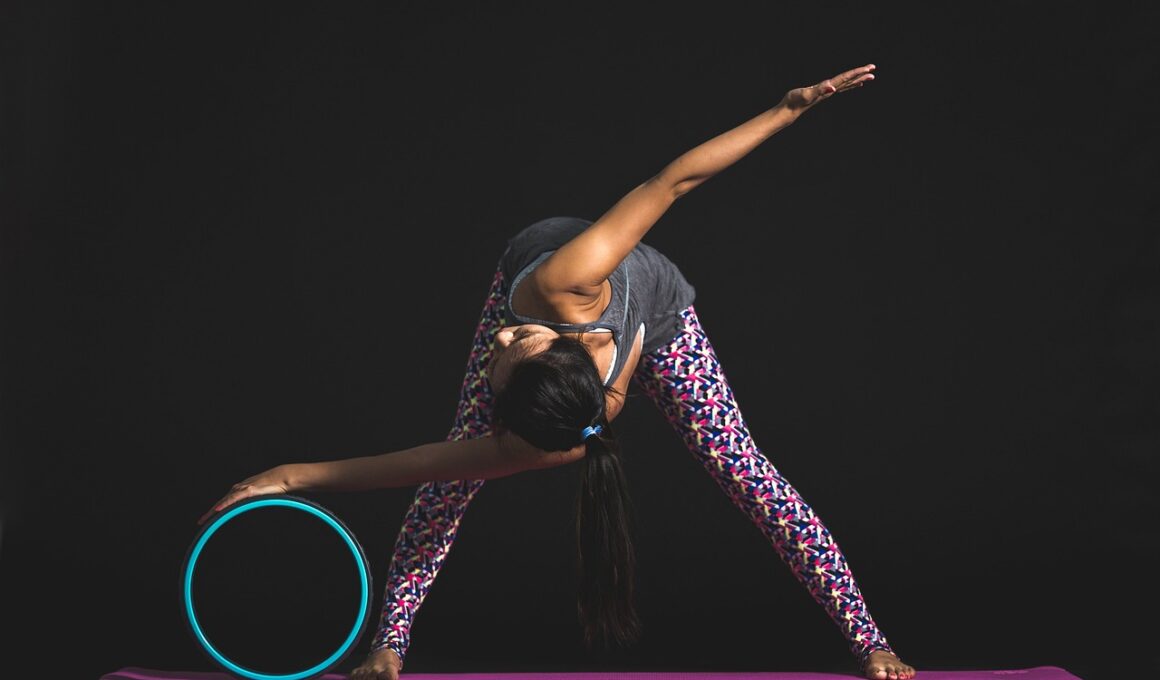How to Choose the Right Yoga Mat for Home Exercise
Choosing the right yoga mat can significantly impact your home yoga practice and overall experience. A quality mat provides comfort, stability, and support as you flow through various poses. When selecting a yoga mat, consider factors such as thickness, material, texture, and eco-friendliness. Thickness typically ranges from 1/16 to 1/4 inches. A thicker mat can provide more cushioning, but a thinner mat allows better grip and stability. Next, examine the material used in your mat, as it affects durability, performance, and comfort. Popular options include PVC, TPE, and natural rubber. Additionally, texture plays a role in grip; mats with a textured surface might provide better traction during sweaty sessions. Take time to research each option. Also, assess the mat’s eco-friendliness. If environmental impact is important to you, look for mats made from sustainable materials or those that are free from harmful chemicals. Knowing these factors can greatly enhance your decision-making process.
Another essential factor to consider is the weight of the yoga mat. If you plan on traveling or going to a studio, a lightweight mat might be preferable for convenience. Mats generally weigh between 1 to 3 pounds, which can make a significant difference when carrying it around frequently. Heavier mats often provide additional stability but may be cumbersome during transport. To find the right balance between weight and performance, prioritize your intended use. If you do most of your yoga practice at home, a heavier mat might be beneficial. Conversely, if you’re on the go often, opt for a lighter mat for easy portability. Your size and body type also play a role; larger individuals may find wider and longer mats provide needed space during practice. So, ensure you consider personal preferences and lifestyles to select a mat that caters to your needs while still being functional and accommodating.
Texture and Grip
Another critical aspect of selecting the ideal yoga mat is understanding textures and grip levels. A mat’s texture can impact stability during various poses, so choosing a surface that supports your practice is essential. Many mats feature either a smooth or textured surface; smooth mats tend to offer less traction, while textured mats generally increase grip. When assessing grip, consider factors like sweat levels. For those who engage in intense yoga sessions and are prone to sweating, a highly grippy mat can significantly reduce slip hazards. Look for mats specifically designed for hot yoga or that feature high-performance materials to enhance grip. Ensure your chosen surface aligns with your practice style and intensity. Various manufacturers offer unique designs and materials, so researching the grip level and texture is crucial before purchasing. This attention to detail will enhance your practice, providing you with the desired stability.
Durability is another important aspect when considering yoga mats for home exercise. As you’ll want your mat to withstand consistent use, investing in a high-quality mat can pay off in the long run. Many lower-end mats can wear out quickly, resulting in the need for replacement. Focus on durability when exploring different materials, as they directly relate to how well a mat will hold up over time. PVC mats tend to be the most durable and can last for many years, while natural rubber and TPE mats may wear out more quickly but are often more eco-friendly. Additionally, consider maintenance aspects; some mats require special cleaning or care to prolong their lifespan. Review user feedback and warranties to assess durability claims from manufacturers. Ultimately, investing in a durable yoga mat from the beginning can save you both money and frustration, providing a reliable exercise surface for years to come.
Price Range
When choosing a yoga mat, the price can vary greatly depending on the quality and materials used. Budget-friendly options typically range from $20 to $50, while premium yoga mats can exceed $100. While it is tempting to go for the cheapest option available, investing a bit more can often yield better results. Higher-priced mats usually feature superior materials, increased durability, and additional comfort that enhances your practice experience. Assess what fits within your budget while also meeting your specific requirements. Finding the right balance between quality and affordability will ensure you get a mat that suits your needs without overspending. Keep an eye out for seasonal sales or discounts, which can provide excellent opportunities to acquire a high-quality mat at a reduced price. Proper research on various brands will also lead to informed purchasing decisions, allowing you to find a great yoga mat without breaking the bank.
When you’ve narrowed down your options, it’s wise to test the mats physically, if possible. Many stores allow you to feel the mats and sometimes even try them out. Testing mats gives you a better sense of their comfort, grip, durability, and overall feel. Pay attention to how the mat feels beneath your hands and feet during various poses. It’s essential that you feel stable and supported. Online testing tools or reviews provide valuable insights, but nothing beats the hands-on approach. If you’re unable to visit a store, look for companies that offer a satisfaction guarantee with reasonable return options. Many reputable brands understand that comfort and usability are vital. Therefore, they will strive to provide an effective return policy for unsatisfied customers. This policy ensures you can get your money back if the mat does not meet your expectations once you’ve tried using it in practice. This flexibility will ultimately lead to a satisfactory purchase.
Conclusion
In conclusion, selecting the most suitable yoga mat involves examining various factors, including thickness, material, texture, weight, durability, and price. Each element contributes to your overall practice, affecting how comfortable and secure you feel. Whenever you settle on one or multiple options, remember to test them if possible to determine compatibility with your personal needs. Don’t solely rely on online reviews; your comfort and experience are paramount. By investing time and effort in researching the right yoga mat for home exercises, you can ensure your workout experience is enjoyable, safe, and effective. So take your time in making this crucial choice; you want a mat that will inspire and support your practice for years to come. Once you find that ideal yoga mat, your home workouts can evolve into an extremely rewarding, enlightening experience that promotes physical and mental well-being. Ultimately, the right yoga mat should resonate with your unique style, making your time spent practicing yoga fulfilling.
By following these guidelines and understanding the key aspects of yoga mat selection, you will find your perfect match effortlessly. Focus on how various features impact your practice’s functionality and comfort to make the best decision. Furthermore, discussing your choices with fellow yoga practitioners may provide valuable insights and recommendations. As you explore the right options, keep your personal goals in mind, helping narrow down the process. With the right yoga mat, home exercise can be transformed into a delightful journey, enabling you to deepen your practice and embrace mindfulness. Each time you step onto your mat, you will feel confident and inspired to continue along your path toward wellness and tranquility.


